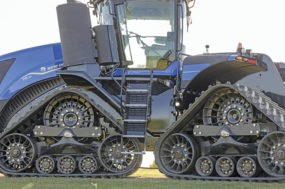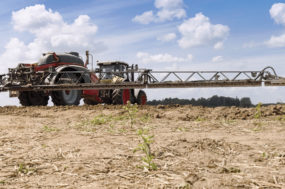Whoever you are, this article is for you.
Some farmers capitalize on the ensilage process because of the economic benefits realized through proper management. However, the silage system is not for everyone.
Ensiling may not be cost-effective in comparison to alternatives, depending on regional climate and the desired end use of the forage product.
For instance, a Southwestern U.S. producer in a dry climate may find storing baled hay outside gives him or her the lowest-cost system without sacrificing quality and ensuring flexibility of end use.
On the other hand, a producer in the Northeastern U.S. may find it difficult to get hay baled, let alone stored outside.
Now that farmers can produce a consistently high-quality feedstock through ensiling, our attention can turn to the manner in which we store the forage.
Preservation of herbaceous crops via anaerobic storage (ensiling) consists of four phases: aerobic, fermentation, stable and feedout (Barnes et al., 2003).
During the first phase, trapped oxygen in the forage pile, bag or bunker (clamp) is utilized by the plant’s biochemical process respiration in which plant sugars are broken down to carbon dioxide, water and heat.
After most of the oxygen is removed (about one day in a well-sealed storage), the anaerobic, or fermentation, phase is dominated by a group of microorganisms known as lactic acid bacteria (LAB), which ferment soluble sugars to organic acids, leading to acidification of the plant material.
As the acidity increases, the activity of anaerobic microorganisms is inhibited, producing a stable forage product. This anaerobic process is key in the prevention of moldy and inconsistent feedstock.
The time needed to achieve the stable phase varies, depending on crop species, rate of oxygen exclusion and moisture content. A typical ensiling duration that produces stable feedstock can be usually attained in 21 to 30 days in properly managed forage systems.
Before we take a look at the final stage of ensiling, let’s dig deeper into the underlying aspects of the fermentation stage.
In order to maintain long-term stability of ensiled forages, several factors need to be considered: the amount of readily fermented carbohydrates, the moisture content and the acidity. Let’s see how we can manage these variables during harvesting and ensiling your crop.
The first consideration is the availability of fermentable carbohydrates. These carbohydrates, typically simple sugars like fructose, glucose and sucrose, are commonly assayed and referred to as water-soluble carbohydrates (WSCs). WSCs are essential to microbial fermentation, as they provide energy for growth.
The availability of these carbohydrates can depend on many factors, including plant species, maturity, length of wilting period and local climate, including drought stress.
Manageable considerations for maximizing WSCs include harvesting at the correct stage of maturity and minimizing duration of field wilting through conditioning, wide-swathing and/or tedding.
Levels of WSCs have also been correlated to planting densities and fertilization rate. Consult your local extension literature for specific details for your growing conditions and crops.
Another primary factor affecting success of silage-making is moisture. Optimal moisture is dependent both on plant species and type of storage structure, but generally the ranges are 60 to 70 percent for covered piles, bunker and bag silos, and 55 to 65 percent for tower silos.
Under these moisture conditions, lactic acid bacteria should ferment some of the silage’s soluble sugars to lactic acid, thereby acidifying the forages and preventing further microbial activity during storage.
At this lower pH, typically between 3.8 and 5.0, depending on the plant species, undesirable microorganisms such as enterobacteria, fungi and clostridia bacteria are inhibited.
Silages too high in moisture can favor the development of clostridia. These organisms produce butyric acid and amines that reduce animal intake and increase dry matter losses.
Properly wilting forage will minimize the amount of fermentable carbohydrates required to raise the acidity. Raising the acidity is essential to preserve the forage and restrict the development of undesirable microorganisms.
In extremely high-moisture forage, nutrients can also be carried away by seepage or effluent as the forage is compressed in the storage structure.
Alternatively, if forage moistures are too low, losses may occur as the result of low forage bulk density and increased porosity.
When the silage is exposed to oxygen, high porosity promotes aerobic respiration, yielding bacterial and mold growth.
This process increases the temperature of the forage and is known as heating. Heating of forage uses sugars and reduces protein digestibility. In severe cases, spontaneous combustion may result (the ultimate dry matter loss).
Inoculants are another management consideration. Inoculants come in many forms, but all contain some strain of lactic acid bacteria.
Applying these bacteria directly to the forage helps ensure proper acidification and, consequently, the preservation of the crop. Inoculants do not, however, make up for other management mistakes such as improper moisture content or densification of the crop.
Research has demonstrated the ability of these additives to reduce dry matter loss and improve animal performance.
The final, oft-forgotten stage of ensiling is feedout. The manner in which feed is removed and the way in which it is packed comprise the feedout stage, which can be essential when examining feed quality.
A properly sealed storage structure full of crop at the optimal moisture content can still lose a significant amount of quality during the feedout phase.
Losses in dry matter can range from 3 to 20 percent, not to mention loss in animal performance on low-quality feed. Opening the bag, bunker or even tower silo exposes the face to air.
The low pH of the forage, which prevented deterioration in an anaerobic environment, will not inhibit aerobic microorganism such as molds and yeasts.
Properly sizing your storage structure to meet your needs can minimize your risk to losses. Your storage structure should be sized so removal rates are greater than six inches per day.
Unfortunately this isn’t the whole story. Feedout losses aren’t limited to the face of the silage but can occur throughout the silage as air works its way back through the storage structure.
This problem is exacerbated by forage stored at a low density as air can more easily diffuse through this more porous material. This highlights the need for both properly sealing a storage structure and proper densification of the crop during ensiling.
Densification can occur by suitably layering and packing the forage during storage filling. The packing process can be improved by reducing the particle size of the forage, but this need must be balanced by considering the animal’s effective fiber requirements specified by your nutritionist.
Paying close attention to densification and sizing of your storage structure can reduce risks of spoilage and lost quality.
Before considering the ensilage system, be sure to find specific information regarding optimal maturity, moisture content and particle size for your crop species.
For more in-depth information about a specific topic related to ensiling forage, including alternative forages, harvesting, inoculation, filling and managing storage, feeding and testing, please visit the University of Wisconsin Cooperative Extension Team Forage website: http://www.uwex.edu/ces/crops/uwforage/uwforage.htm FG
References omitted but are available upon request at editor@progressivedairy.com
Matthew Digman
Assistant Professor & Extension Specialist
University of Wisconsin – Madison









